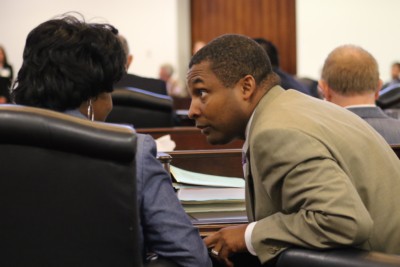

You would not automatically know it from the dominant headlines and the TV talking heads, but the outcome of the raging health-insurance debate in Washington will have profound consequences for millions of school children — and infants, toddlers, and preschoolers, too.
A critical feature of the Republican-sponsored legislation — passed by the U.S. House and pending in the U.S. Senate — would scale back Medicaid, the 52-year-old program of coverage for poor adults and children, people with disabilities, and nursing home residents. The Congressional Budget Office estimates the measures would reduce federal Medicaid spending by around $800 billion over a decade.
In North Carolina, a state where 23 percent of children live in poverty, Medicaid and the companion Child Health Insurance Program (CHIP) enroll more than 1.2 million young people. Thus children represent more than half of the overall Medicaid-CHIP enrollment of 2.26 million. What’s more, Medicaid covers more than half the births in North Carolina.
Under the current system, adults qualify for Medicaid with income of no more than about 44 percent above the federal poverty level (or ~$9,000/year for a family of 3). Children qualify from households earning up to 200 percent of the poverty standard (~$41,000/year for a family of 3). In families with low-income working parents, it is possible for children to get Medicaid coverage even if their parents do not. And, the Kaiser Family Foundation points out that 74 percent of adults and children enrolled in Medicaid are in families with a worker.
In North Carolina, about 55 percent of public school children qualify for free- and reduced-price lunch — an indicator of how many students live in poverty or lower-income households. No doubt, a large segment of students qualify for both the lunch program and Medicaid. And it goes without saying that health in mind and body serves as a solid precondition for student learning. The Kids’ Count DataBook of the Annie E. Casey Foundation reports that more than 7 percent of North Carolina school children missed 11 or more days of school due to illness or injury in 2012, the most recent data available.
Unlike Medicare, under which the federal government provides insurance to older adults, Medicaid functions as a federal-state collaboration, with the federal government spending about $2 for every $1 spent by the state. In total, Medicaid cost $12.4 billion in 2016 in North Carolina.
With the Senate having delayed a vote until after the July 4 holiday, it is not clear whether the measures to “repeal and replace’’ Obamacare will be enacted and, if so, in what ways will it rollback Medicaid. One option is to provide states with per-capita allotments; another is to send block grants to the states.
“The way the cuts are structured has a huge effect on states,” said Pam Silberman, a professor of the practice in the UNC School of Public Health who has studied Medicaid for many years.
If enacted, she said, the outlook is for “less and less adequate’’ federal funding, putting pressure on state officials to make hard choices — whether to cut people off Medicaid, to eliminate some services covered, or to reduce payments to physicians and hospitals.
“States could be forced to make huge cuts to provider payments, which would lead to fewer providers to treat Medicaid children,” said Silberman. And, she said, the national legislation may lead to “equally bad choices’’ for middle-class families with children in seeking coverage in the private insurance market: They are likely to face plans with higher premiums and higher deductibles.
“Under the current proposals being considered by Congress,” Silberman said, “states could pare down the services insurers must include —such as mental health or substance abuse coverage or coverage for rehabilitative services. These are really important for children, especially kids with special health needs.”
A large 50-year-old program in the complex arena of health care naturally requires regular adjustments. Still Medicaid and CHIP together can be seen as a success story in terms of wider insurance coverage of North Carolina’s young people than adults. Approximately 93 percent of children in North Carolina are covered by either public or private health insurance. That still leaves more than 100,000 uninsured today. However, the situation would be far worse if Congress passes the legislation under consideration, with the Congressional Budget Office projecting the ranks of the uninsured expanding dramatically.
The Kaiser Family Foundation has a data-rich profile of Medicaid in North Carolina. And the Kids’ Count DataBook has a large array of North Carolina data.
For more discussion about Medicaid in North Carolina, see Rose Hoban’s North Carolina Health News report and an editorial page essay in The News and Observer by David T. Tayloe Jr., M.D., of Goldsboro, past president of the N.C. Pediatric Society and American Academy of Pediatrics.


